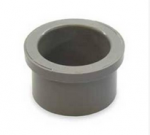I'm trying to understand max bending radius for conductors relating 300.34 and the tables in the back for approximate diameter.
I remember a discussion years ago where someone came out of the back of a 200 amp meter pan (single phase 3 wire) and a comment was made that that size wire was a violation of bending radius.
The person who did the install said he used a box adapter (attached) and there for the radius was good.
Since that time, I've always made it a point to come out of the bottom of a meter pan to avoid any issues. Yet, as I look around as I'm driving I see tons of 200 amp services with nothing coming out of the bottom of the meter pan. SO, I assume they're all coming out of the back of the meter pan.
Are they all installed using box adapters or are inspectors just not catching it or just letting it go ( kinda like I see all these exposed service conductors in driveways in schedule 40 and not sch 80 or emt or rmc)?
Is the box adapter ok for not having to use a bushing?
Looking around you tube I can't find anything for USA conductor bending radius videos to help explain this and how I would measure from where the conductor enters to the terminal or opposite end of a box.
Can any one here easily explain it?
For instance, If I use 4/0 seu al. I would go to the table for thhn,thwn,thwn-2 (table 5) which has an approximate diameter of .642. So 8 (from 300.34) x .642 (from table 5) = 5.136 What do I do with this number ?
xhhw-2 has a approximate diameter of .638
Would I measure from where the conductor comes out from the bushing to the terminal in a straight line and it can't be closer than 5.136"? Is this it or am I way off.
I will continue looking.
Thank you
I remember a discussion years ago where someone came out of the back of a 200 amp meter pan (single phase 3 wire) and a comment was made that that size wire was a violation of bending radius.
The person who did the install said he used a box adapter (attached) and there for the radius was good.
Since that time, I've always made it a point to come out of the bottom of a meter pan to avoid any issues. Yet, as I look around as I'm driving I see tons of 200 amp services with nothing coming out of the bottom of the meter pan. SO, I assume they're all coming out of the back of the meter pan.
Are they all installed using box adapters or are inspectors just not catching it or just letting it go ( kinda like I see all these exposed service conductors in driveways in schedule 40 and not sch 80 or emt or rmc)?
Is the box adapter ok for not having to use a bushing?
Looking around you tube I can't find anything for USA conductor bending radius videos to help explain this and how I would measure from where the conductor enters to the terminal or opposite end of a box.
Can any one here easily explain it?
For instance, If I use 4/0 seu al. I would go to the table for thhn,thwn,thwn-2 (table 5) which has an approximate diameter of .642. So 8 (from 300.34) x .642 (from table 5) = 5.136 What do I do with this number ?
xhhw-2 has a approximate diameter of .638
Would I measure from where the conductor comes out from the bushing to the terminal in a straight line and it can't be closer than 5.136"? Is this it or am I way off.
I will continue looking.
Thank you



